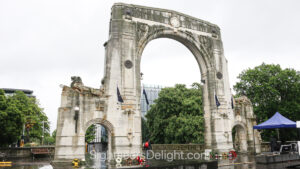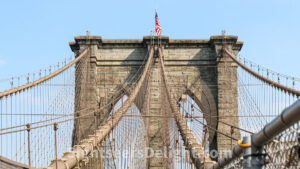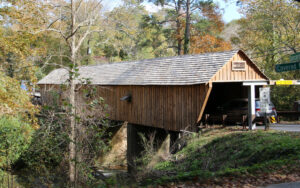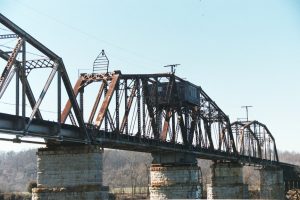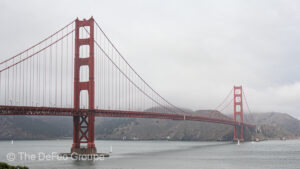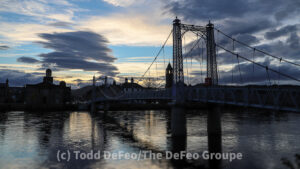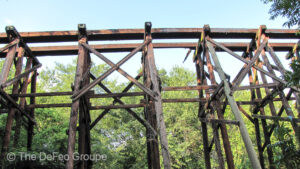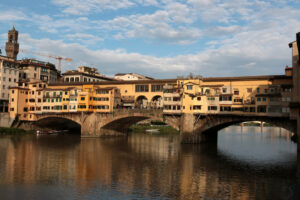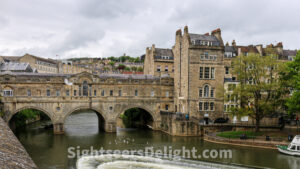The Bridge of Remembrance in Christchurch, New Zealand, is dedicated to as a memorial to those who participated in World War I and World War II as well as conflicts in Borneo, Korea, Malaya and Vietnam. The Cashel Street bridge over the Avon River initially opened in 1873. Mrs. Wyn Irwin is credited with raising the idea for a memorial atop the bridge in a July 24, 1919, letter to The Press on 24 July 1919. Lord Jellicoe unveiled the monument on Armistice Day (Nov. 11) in 1924. It closed to vehicle traffic in 1976. Following the February 2011 Christchurch earthquake, New Zealand spent more than NZD 2 million to strengthen the historic bridge.
The Brooklyn Bridge is perhaps the most famous bridge in the United States. The hybrid cable-stayed/suspension bridge spans the East River and was completed in 1883 to connect Manhattan and Brooklyn. The bridge was originally known as the New York and Brooklyn Bridge and the East River Bridge.
The Concord Covered Bridge over Nickajack Creek was built in 1872 to replace an earlier bridge destroyed during the Civil War. The one-lane bridge, also known as Nickajack Creek Covered Bridge, is more than 130 feet long and 16 feet wide and is a part of the Covered Bridge Historic District, so named for the bridge. An earlier bridge was built in the area in 1848, but troops under Union Gen. William T. Sherman burned the span on July 4, 1864. The current bridge was renovated or upgraded in the 1950s and again in 1999. Much of the traffic that used to cross the bridge was diverted to the East-West Connector when it opened in the 1990s. The one-lane bridge has a relatively low clearance, and several times every year motorists driving vehicles too big for the bridge crash into the structure and damage it.
30082
The most impressive railroad relic in Clarksville, Tenn., is the swing bridge over the Cumberland River. With stone pillars dating to 1859, the 678-foot-long bridge is normally more than 50 feet above the river and can swing to allow river traffic to pass when the water level is high.
The Golden Gate Bridge is an icon of San Francisco. The famed bridge opened on May 27, 1937. To experience the bridge’s magnitude, head to Fort Point. This well-preserved Civil War era post is located on the southern side of the Golden Gate strait at the entrance of San Francisco Bay.
The Greig Street Bridge is a suspension bridge across the River Ness in Inverness and is open only to pedestrians. Dating 1880-81 and built by the civil engineer C. Manners in conjunction with the Rose Street Foundry for a cost of £1,400, it is composed of two side spans of 67 feet and a central span of 201 feet. Its cables were replaced in 1952, and the anchorages were replaced in 1989.
The “Murmur Trestle” has for years attracted R.E.M. fans from around the globe. Gracing the back of the band’s 1983 album “Murmur,” the bridge is best known today as the Murmur Trestle. The trestle was built in 1883 and served the Georgia Railroad and later CSX Transportation and was last used in 1998. Athens-Clarke County purchased the trestle in 2000.
30601
The Ponte di Rialto (or Rialto Bridge in English) is one of the most famous bridges in Italy. The structure is the oldest of the four bridges spanning the Grand Canal in Venice and connects the districts (sestieri) of San Marco and San Polo. It was first built as a pontoon bridge in the 12th century but has been rebuilt several times since then.
The Ponte Vecchio (Old Bridge) traverses the narrowest point of the Arno river. The current bridge dates to 1345, and miraculously, German troops didn’t destroy the bride as they fled the city during World War II. It is noted for shops along the bridge.
The Pulteney Bridge is a historic bridge in Bath, England, spanning the River Avon. It was constructed in 1774 to link the city with the Pulteney family’s land, which they wanted to develop. Robert Adam designed the bridge, which features a unique Palladian style with shops built on both sides. It has been classified as a Grade I listed building. Within two decades of its completion, the shops were expanded, and the façades were altered. Floods damaged the bridge by the end of the 18th century, but it was rebuilt with a similar design. In the following century, renovations were made to the shops, including cantilevered extensions on the bridge’s north face. Later in the 20th century, preservation efforts were carried out to restore the bridge’s original appearance, making it more attractive as a tourist destination.

